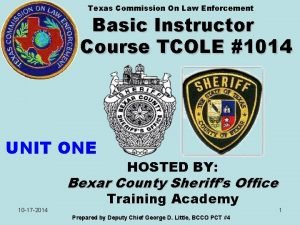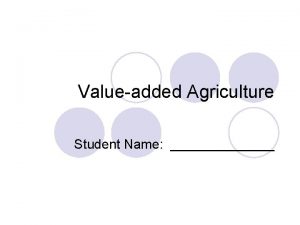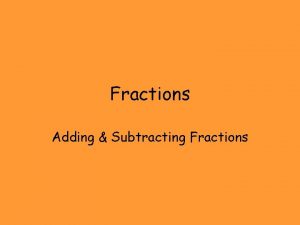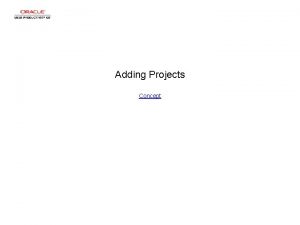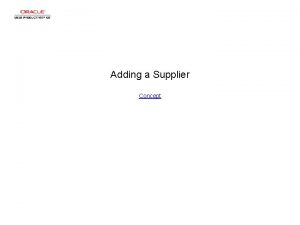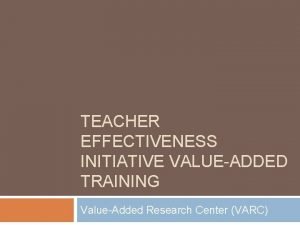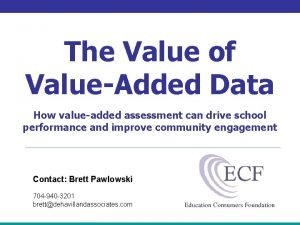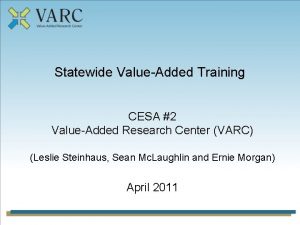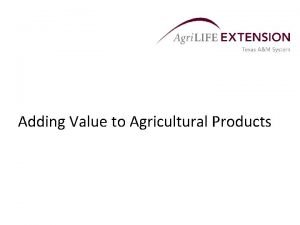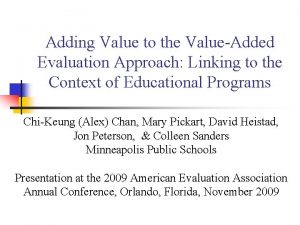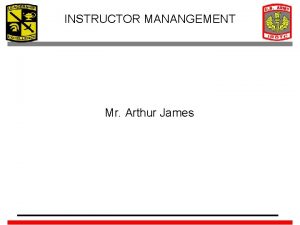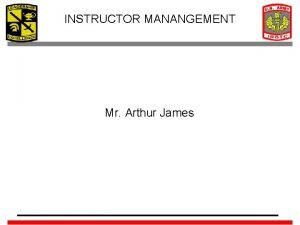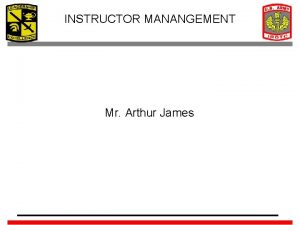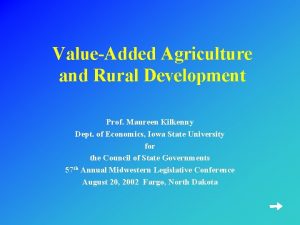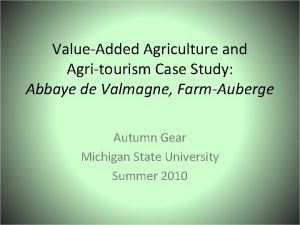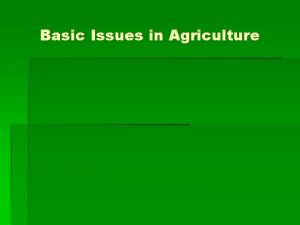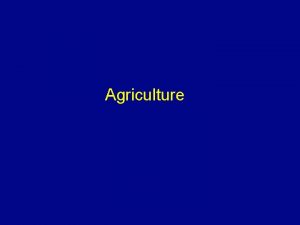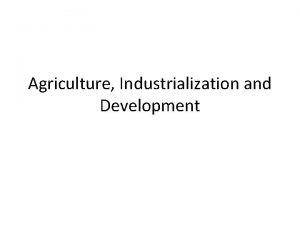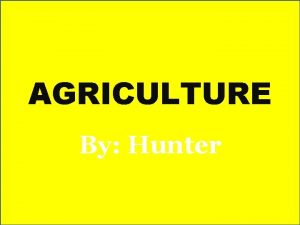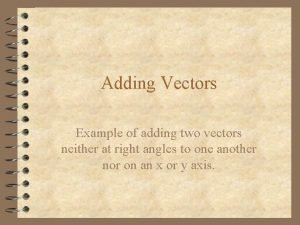Valueadded Agriculture Instructor What is ValueAdded Agriculture Adding

































- Slides: 33

Value-added Agriculture Instructor:


What is – Value-Added Agriculture? • Adding Value – Process of changing or transforming a product from its original state to a more valuable state Add value to wheat By processing it into a product (flour) Desired by customers – (bread bakers)

BUT – Raw Commodities already have value? ! • Many raw commodities have value in their original state. • They are raised by an agricultural producer; then sold by that producer for further processing • Corn, wheat, weaned calves, market lambs, watermelons etc. all HAVE value. They are worth something.

$$Money, Money$$ Could producers get MORE $$$ for their products if they – • Grew products differently • Physically changed their products before selling them • Coordinated with an agribusiness to change the way their product was marketed? www. acclaimimages. com

Adding Value in a Changing Agricultural World • It’s important to identify value-added activities that support investment in research, processing & marketing • Additional opportunities for adding value include: • Applying biotechnology • Food engineering (raw product to consumable forms) • Restructuring food distribution systems.

“I Produce Food” • Producers are members of a food company • Producers produce, process, and market food to consumers • ‘I am a rancher; I raise steak & hamburgers’ is the new way of thinking

• Take out a blank piece of paper http: //www. beaverandsteve. com/wiki/index. php? title=Sir_Isa ac_Newton • Everyone write ONE ‘why’ question that relates to the information we just copied into our notes.

• For ALL of the Capturing vs. Creating Value Slides (there are 10 of them)– take a few minutes and draw a quick picture next to the definitions. • Make sure the picture represents the definition to YOU – the Learner! www. cs. miami. edu

• Adding value to products can be accomplished in a number of different ways, but generally falls into one of two main types: • Creating Value • Innovation • Industrial Innovation • Capturing Value • Coordination

• Creating Value – occurs with actual or perceived value to a customer for a superior product or service • Innovative new products • Enhance a product’s characteristics • Enhance services • Create brand names • Develop unique customer experiences

• Creating Value through - Innovation: Improving existing processes, procedures, products and services or creating new ones • Market unique or branded products • Produce identity-preserved or specialty crops • Combine family activities or recreation associated with direct on-farm marketing

• Creating Value through - Industrial Innovation: Processing traditional crops into nonfood end uses • Ethanol from corn • Biodiesel from soybeans • Particleboard from straw

• Capturing Value: Changing the distribution of value in the food/fiber production chain. • Meant to ‘capture’ more of the consumer dollar through: • Direct Marketing • Vertical Integration • Producer Alliances • Cooperative Efforts

• Direct Marketing • Selling products directly to the consumer • Selling beef animals ‘on the hoof’ • Selling homemade soaps & lotions to the general public • Think – e. Bay! http: //images. google. com/imgres? imgurl=http: //www. insidefurnitur e. com/insidefurniture/images/marketing_cartoon_1. jpg&imgrefurl= http: //www. insidefurniture. com/insidefurniture/blogservation/inde x. html&h=224&w=309&sz=24&hl=en&start=16&tbnid=KN 8 Rhgvh DYw 8 NM: &tbnh=85&tbnw=117&prev=/images%3 Fq%3 Ddirect%2 Bmarketing%2 Bcartoon%26 gbv%3 D 2%26 svnum%3 D 10%26 hl%3 D en%26 client%3 Dfirefoxa%26 channel%3 Ds%26 rls%3 Dorg. mozilla: en. US: official%26 sa%3 DG

• Vertical Integration – One producer or business owns the product from beginning to end. This producer or business doesn’t sell the product until the consumer purchases it: • Tyson Chicken - http: //images. google. com/images? svnum=10&hl=en&gbv=2&client=firefox-a&channel=s&rls=org. mozilla%3 Aen. US%3 Aofficial&q=Tyson+Chicken&btn. G=Search+Images

• Producer Alliances: Individuals / companies from the same level of the food chain consolidate in order to produce and market a superior product

• Cooperative Efforts: Individuals or companies pool their products in order to increase bargaining power.

• Minimizing Costs: • Before producers can explore valueadded processing and marketing they MUST minimize production costs • Only low cost and efficient producers will survive • Adding value cannot take the place of good management


• Many times adding value requires a combination of techniques • These techniques provide producers with a competitive advantage in the marketplace • There are 6 strategies for adding value

6 Key Strategies for Adding Value • Changing physical state of products • Producing enhanced value products • Differentiating products • Bundling products • Producing more products that improve efficiency up the supply chain • Owning assets up the supply chain

• Changing • Milling wheat into the physical flour state / form • Making of products strawberries into jam • ‘Feeding’ alfalfa into a biomass generator

• Producing products in ways that enhance value • Growing organic crops • Producing antibiotic and hormone-free beef • Producing freerange chickens

• Differentiating • agricultural products in order to enhance their • value Selling beef under a branded beef label Marketing ‘heat & eat’ pot roasts • Selling preseasoned corn on the cob

• Bundling Products • Beef and wool producers jointly market beef & flavored wood chips for the ‘ultimate grilling experience. ’ • Greenhouse growers sell pre-planted hanging baskets

• Producing & marketing commodities that improve operating efficiency up the supply chain • Produce new wheat varieties that improve milling & baking efficiency. • Processors are willing to pay a higher price for the wheat

• Corn producers • Owning assets begin producing somewhere up ethanol the supply chain for • Cattle producers further process & sell processing their own meat • Dairies market their own organic ice cream

• • Producers use one (or more) of these six strategies: 1. Customer base is expanded 2. Producers receive greater portion of revenue 3. Producers receive strategic advantages in the marketplace BOTTOM LINE: - Producers make more $Money$

Producers used to have a ‘produce-thensell’ mentality • Producers grew crops or livestock • Hoped to find a buyer • ‘Took whatever price was offered that day TODAY’s Agriculture includes: • FIRST determining what consumers want in their food products • THEN creating those products

• Agriculture is moving towards a global economy • The international market for valueadded products is growing • Consumers have increasing health, nutrition, and convenience needs • Food processors want to improve productivity • Technology enables producers to produce what consumers WANT!

Producers who add value will become more than commodity producers – • They will be preparing food for end-users • Quality, variety & packaging are important • Price is not as important as quality They will be producing consumable products – (steaks, hamburgers, bread, Poptarts etc. )

 Instructor operating station
Instructor operating station Ames room
Ames room Basic instructor course #1014
Basic instructor course #1014 Cisco certified instructor
Cisco certified instructor Cbrf wisconsin registry
Cbrf wisconsin registry Participante novato
Participante novato Catia instructor
Catia instructor Tcole advanced instructor course
Tcole advanced instructor course The virtual instructor
The virtual instructor Njrotc instructor vacancies
Njrotc instructor vacancies Pepperball hotshot
Pepperball hotshot Delmar cengage learning instructor resources
Delmar cengage learning instructor resources Mptc firearms instructor manual
Mptc firearms instructor manual Nra certified instructor logo
Nra certified instructor logo Basic instructor course tcole
Basic instructor course tcole Instructor
Instructor Tcole advanced instructor course
Tcole advanced instructor course Calcaneum plural
Calcaneum plural Nfpa 1403 instructor to student ratio
Nfpa 1403 instructor to student ratio How to become an nrp instructor mentor
How to become an nrp instructor mentor Neither of my two suitcases are adequate for this trip
Neither of my two suitcases are adequate for this trip Instructor office hours
Instructor office hours Tcole advanced instructor course
Tcole advanced instructor course Naismith was an instructor of
Naismith was an instructor of Basic instructor course texas
Basic instructor course texas Ac61-98 plan of action
Ac61-98 plan of action Jrotc marksmanship instructor course online
Jrotc marksmanship instructor course online Basic instructor course #1014
Basic instructor course #1014 Human factors instructor
Human factors instructor Instructor vs teacher
Instructor vs teacher Utp cable
Utp cable Basic instructor course texas
Basic instructor course texas Please clean your own room
Please clean your own room Basic instructor course tcole
Basic instructor course tcole



























